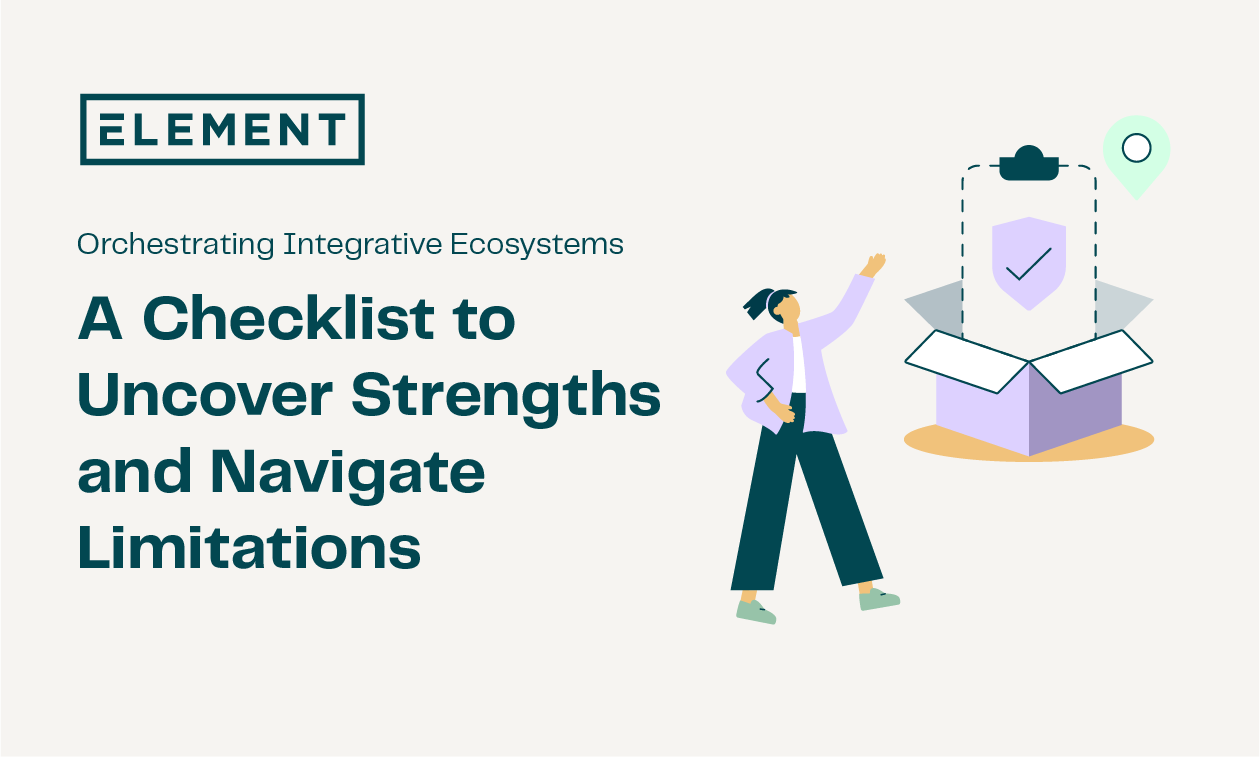
Integrative Ecosystems: A Checklist to Uncover Strengths and Navigate Limitations
Integrative ecosystems strive to offer a seamless customer experience to the end-users. Different team players connect seamlessly through certain values, rules and shared technologies. And to take part in a collaborative ecosystem, next to being a team player, you have to be aware of your strengths and know also your limitations to collaborate on eye level and foster an environment where team members genuinely understand each other's perspectives.
As a company, do you know your boundaries? A question which sounds easy but is harder to answer than one would think. In general, knowing your boundaries is one of the most crucial bases for partnering with others. You can only find the right partner if you know the strengths, weaknesses and limitations of your company and evaluate them fairly and honestly. It is also about selecting partners in your own core business and beyond, who help to close certain gaps to round off the service experience.
Starting with what can you already do today
If you want to assess the strengths, weaknesses, and limitations of your company, it is crucial to examine various aspects to start with. In particular:
-
- your given resources,
- your tech foundation
- your way of working and operations across the entire value chain of your offerings
Consider an insurance company that encompasses the entire spectrum within the insurance value chain, from the initial customer contact through various communication channels, to the offer, policy, service, and claims processes, along with pricing and underwriting, and of course the necessary insurance licenses in place to do business. Every element of the value chain has different requirements and should be evaluated along the three mentioned areas: resources, tech basis and way of working. The following set of questions can be a first guideline to go through and should not only be answered for each component of the value chain individually but also an overarching assessment for the entire company.
It's crucial to acknowledge that any robust assessment will naturally delve deeper than the suggestions outlined here. The ensuing questions represent a high-level curation, focusing on the main areas to guide your evaluation.
(1) Your given resources: people & budget
A critical evaluation of your company's given resources becomes the compass guiding your journey towards sustainable growth and innovation in an integrative ecosystem. Coming back to the metaphor of our previous article on ‘team play’, the foundation for success lies in the careful orchestration of resources, both human and financial.
Questions surrounding the capacity and experience of your workforce are key. Consider whether your team possesses not just the right expertise and team size but also the mindset, personality, and experience required to move each value chain component forward.
a. What resources – in terms of budget and people - do you have in place to manage and develop the company and each part of the value chain further?
b. What capacity of people do you have?
Do you have the right capacity of people with the right mindset, personality, and experience to develop each of the value chain further?
Their knowledge of how things can be done differently should be a driving force. Look for a first-mover attitude, an outward-looking mindset, constantly seeking opportunities and staying attuned to industry advancements.
c. What experience do they bring to the table?
Go beyond mere titles like junior, senior etc., as what really matters is the real work experience within the value chain part and with current and future technology not only internal but in the market.
d. Do you have the sufficient budget at hand, which you can count on continuously and won’t be a blocker?
Ensure a continuous and ample budget for the ongoing development of your internal team, cultivating the right mindset and skills for future challenges. Strategically allocate resources for hiring the right talent and supporting external expertise. Recognize the value of seasoned professionals by earmarking budget for senior internal and external experts. Don't overlook the importance of market data for decision making. Finally, invest wisely into the development of your tech infrastructure and supporting tools. Consider not only one of budget but recurring budget needs. This holistic approach positions you not just to adapt but to lead with confidence and agility in this ecosystem landscape.
e. What budget constrains do you have? Can this block any work within an integrative ecosystem? Can this block any new service experience which will be built together with other partners? Can this lead to “your company” being the blocker for the whole launch of the new solution?
(2) Your given technology foundation
A comprehensive examination of your technological infrastructure is essential for taking part in an integrative ecosystem. Begin by dissecting the architectural setup, scrutinizing the relevance and current state of systems deployed in each value chain component. Assess their status in comparison to industry peers and benchmark against the latest technological advancements both within and beyond the insurance sector.
a. How does the architectural set up look like?
b. What systems are relevant for each part of the value chain and what is their status?
c. Can the systems and applications be updated on a on demand basis or are there any blockers due to longer release cycles or dependencies of different technology stacks?
d. Is the technology capable of integrating with ‘the newest technology’ in the market - not only insurance but e-commerce and tech?
Even if you've got some old-school monolithic systems in place, the real game-changer is having a communication layer or service-level platform to connect to other more common market technologies. This becomes the superhero cape, helping you leap over potential barriers from those legacy systems. The key is not just to think about it but to have the in-house experience to seamlessly connect with platforms that can supercharge your tech stack. It's not just about keeping up; it's about enlarging the way you can work and staying ahead of the curve.
e. Can you showcase a proven track record of effectively engaging with every facet of the value chain, not just internally but also with external parties such as partners, technologies, and resources, without encountering significant blockers?
(3) Your way of working including supporting technical environments
When assessing the insurance value chain, your operational approach emerges as a pivotal factor influencing both internal efficiency and receptiveness to external innovations. Start by examining the internal way of working within your company—the collaborative dynamics and team, project and tech coordination that drive the value chain. Explore your organizational culture's openness to external enrichments, be it through services, resources, or cutting-edge technologies. This exploration is instrumental in elevating your value chain, fostering innovation, and promoting collaboration within a well-integrated ecosystem.
a. Do you have a blueprint of how you work within your company?
b. How would you describe your culture of working? Do you have an open culture of enriching parts of the value chain with external services, resources & technologies?
c. How does your company approach decision-making – is it characterized by full ownership and expertise-driven autonomy, or does it adhere to hierarchical structures and lengthy decision trees?
d. What is your preferred implementation style – following a Waterfall approach or utilizing independent sprints?
How does your implementation within different teams work out? Can teams ideate, develop, test, and implement in parallel without blockers, or are there dependencies on resources, technology, and implementation cycles?
e. Regarding implementation timing, do you adhere to fixed release cycles with a set number of deployments each year (e.g., 1-2), or do you follow short time sprints, enabling on-demand deployments, ideally on a weekly basis?
How to assess your company capacity
Looking at this set of questions along the three categories resources, tech basis and way of working it is not easy to get to a fair and honest assessment of these. Depending on who you involve on this assessment, you will get a varying picture of your company. Much like viewing oneself in the mirror at different times of the day, the assessment outcome is subject to the evaluators' mood, mindset, and feelings. The work-mirror analogy extends further; the experience, personality, and mindset of those engaged in the assessment paint diverse images of the same company facet. While admittedly a simplified analogy, it serves as a metaphorical reminder to set aside emotional biases and pursue a factual, objective evaluation.
Therefore, to come to a fair and honest assessment of the main strengths and weaknesses of your company one should have the right team in place to assess the status quo and use a variety of tools for the assessment. A few examples below:
1. Involving the right team
One needs the right mindset, experience and cultural background to get a fair evaluation, looking into the mirror and describing of how it really looks like with no emotions, or overbrushed or slightly diluted versions of the truth due to mindset and personality of those assessing.
a. Objective self-reflection, avoiding emotional biases.
b. Varied experience across the value chain, technology, and diverse cultural backgrounds.
c. A mix of internal and external perspectives, including extreme views.
2. Utilize the right tool set
There is a variety of tools one can use for the assessment – a few to consider are:
a. High level to low level view: Compare helicopter view from management to core expert view to external customer view.
b. 'Stop, Start, Continue' analysis for each part of the value chain.
c. SWOT analysis comparing to both the peer market and fast-developing markets.
d. Insight out view from external perspectives.
e. Learning from failure experiences to improve and innovate.
This three-tiered assessment covering resources, technology, and the way of working provides a comprehensive understanding of strengths and weaknesses.
Imagine you identified a conflict of overall resources and needs within all parts of the value chain. You can continue to focus on all parts going forward. This potentially leads to moving only slightly forward and struggling to find the perfect solution. Or for a particular service experience, you can consider partnering with others to insure the greatest experience for the end customer. This means you are starting to be part of an integrative ecosystem, where not everything what you have on offer is provided by yourself but only parts of it. However, the part you bring in is at the best level needed and you have the resources, technology and way of working in place which meets the requirements of the whole integrative ecosystem. Considering white-label partnerships for certain parts of the value chain can be a strategic move, fostering an integrative ecosystem where each contribution is optimized, meeting the requirements of the entire ecosystem
It's essential to resist the temptation of mere self-affirmation, as it is easy to look into the mirror and say “you look great, you are the best, nobody can stop you, you can do it on your own”. This will however not bring the success you need if you want to create long-lasting, successful end-to-end customer experiences.
ELEMENT can cover the entire insurance value chain, and our partners can choose the individual elements while always remaining in full control of the distribution. Working with insurers as partners allows for additional flexibility in reinsurance rearrangements and set ups. We believe in empowering our partners to create & distribute personalised insurance products for their customers and to build strong ecosystems.

